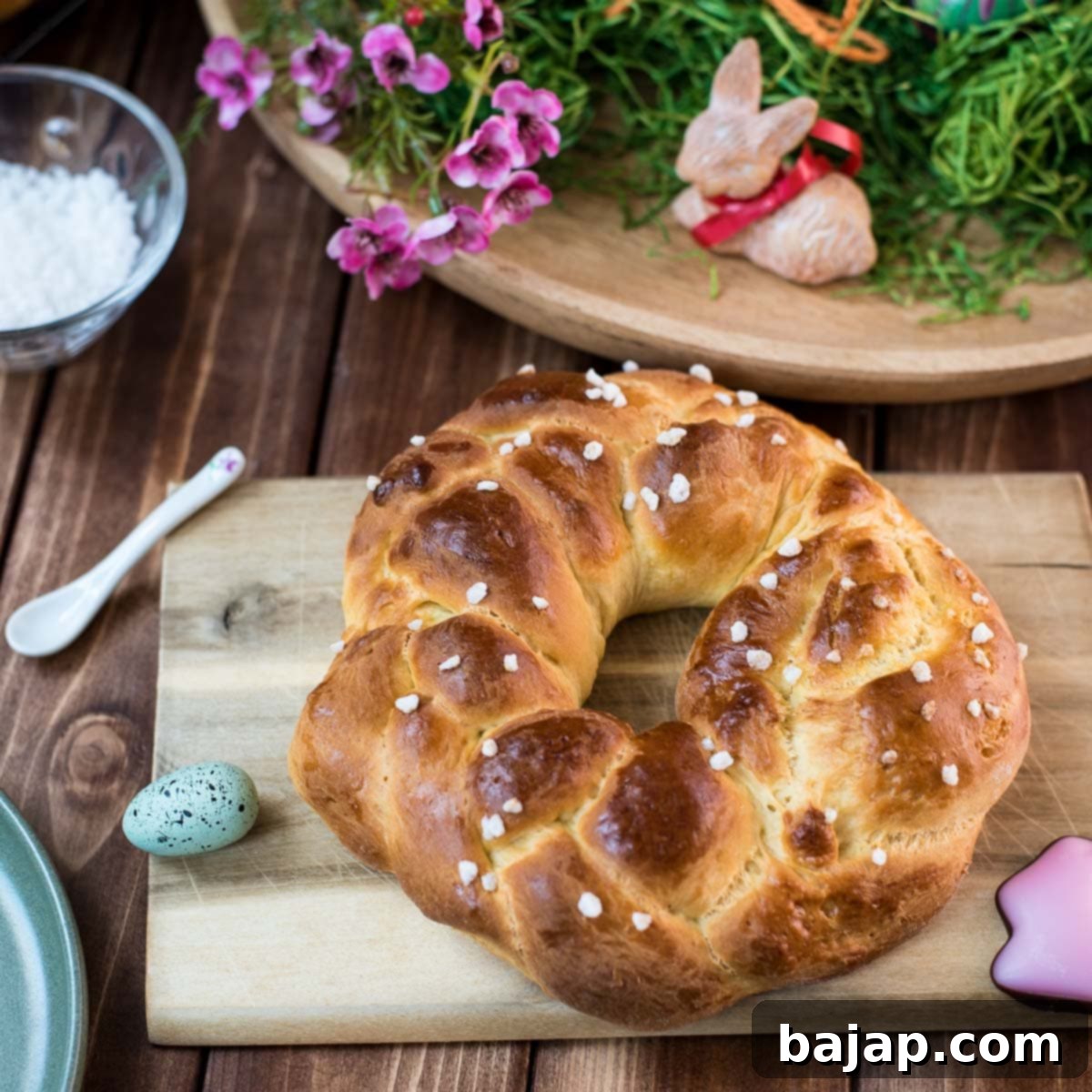Soft & Fluffy Braided Easter Bread Wreaths: A Festive Family Favorite
Easter is a cherished time of year, filled with togetherness, renewal, and, of course, an abundance of delicious treats! Among the many delights, these adorable Braided Easter Bread Wreaths stand out. Imagine tiny, golden circles of soft, fluffy dough, intricately braided and baked to perfection – they look just as delightful on your holiday table as they taste. These lightly sweet, citrus-infused bread wreaths are more than just a dish; they’re a celebration in themselves.
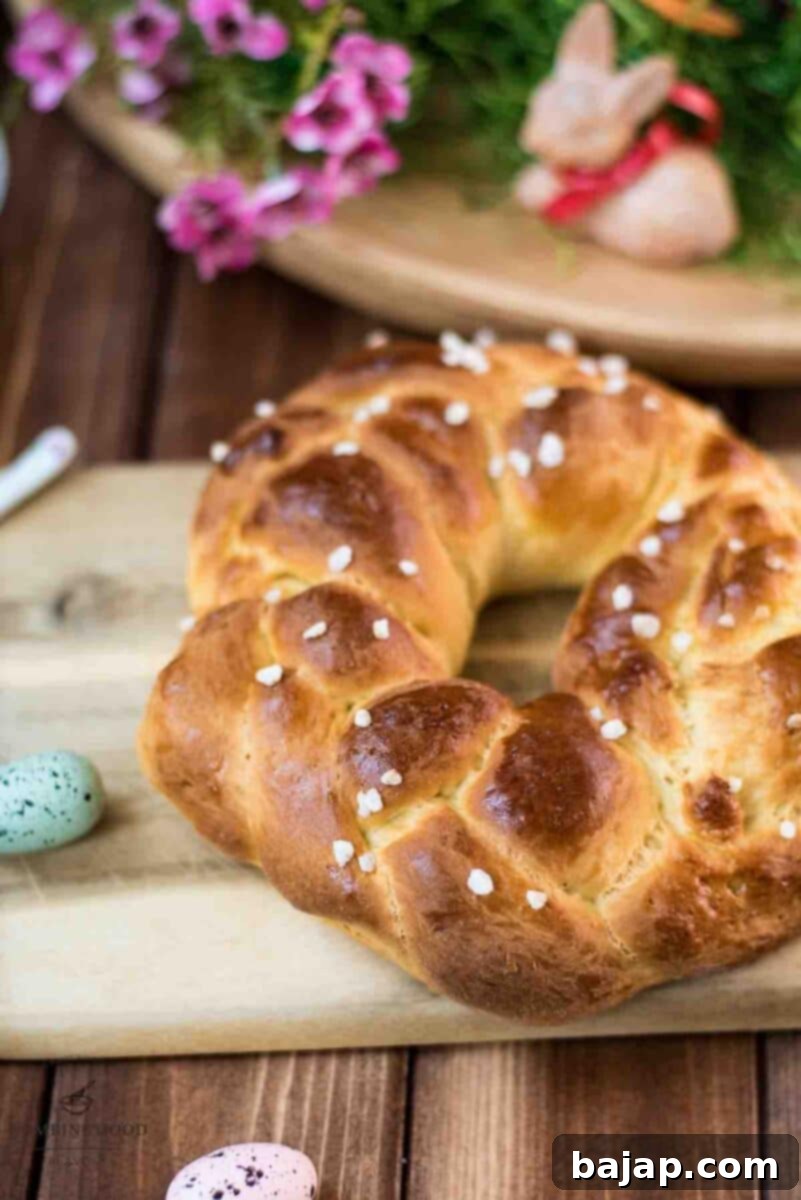
Whether you prefer them simply with a generous slather of butter and jam, or if you’re feeling adventurous and want to explore a savory twist with succulent ham and pungent horseradish, these charming Easter Bread Wreaths are guaranteed to be the star of your Easter brunch spread. For a truly memorable feast, consider pairing them with a refreshing Aperol Mimosa or a vibrant Blackberry Raspberry White Wine. This combination promises an Easter celebration worth savoring!
Why These Braided Easter Bread Wreaths Are So Special
For many, including myself, Easter is deeply intertwined with cherished traditions and heartwarming family gatherings. Since my daughter’s birth, our family has celebrated Easter in the beautiful region of Carinthia with my mother-in-law. There, Easter morning tradition kicks off with a lavish, hearty brunch, the centerpiece of which is always the much-anticipated Consecrated Easter Ham. And, as any Carinthian will tell you, no Easter table is truly complete without a generous slice of Reindling—a sweet, spiraled yeast cake, famously rich with cinnamon, sugar, and raisins, baked to a beautiful golden perfection. Our braided bread wreaths capture that same spirit of tradition and home-baked goodness, offering a slightly simpler yet equally festive alternative that brings joy to every bite.
Beyond their delightful taste and festive appearance, one of the best aspects of these Braided Easter Bread Wreaths is how incredibly easy they are to make. Even better, you can prepare the dough and shape the wreaths the day before, allowing for a truly stress-free holiday morning. This means less time in the kitchen on Easter day and more time enjoying precious moments with your loved ones. So, gather your ingredients, put on your apron, and let’s get baking to infuse a little extra joy and homemade warmth into your Easter celebration this year! 💛🐣✨
🥘 Ingredients for Your Perfect Easter Bread Wreaths
Crafting these beautiful braided bread wreaths starts with a selection of simple, wholesome ingredients that come together to create a rich, fluffy, and subtly sweet dough. Each component plays a vital role in achieving that perfect texture and flavor. Make sure all your ingredients are at room temperature, especially the eggs and butter, for optimal dough consistency and rise.
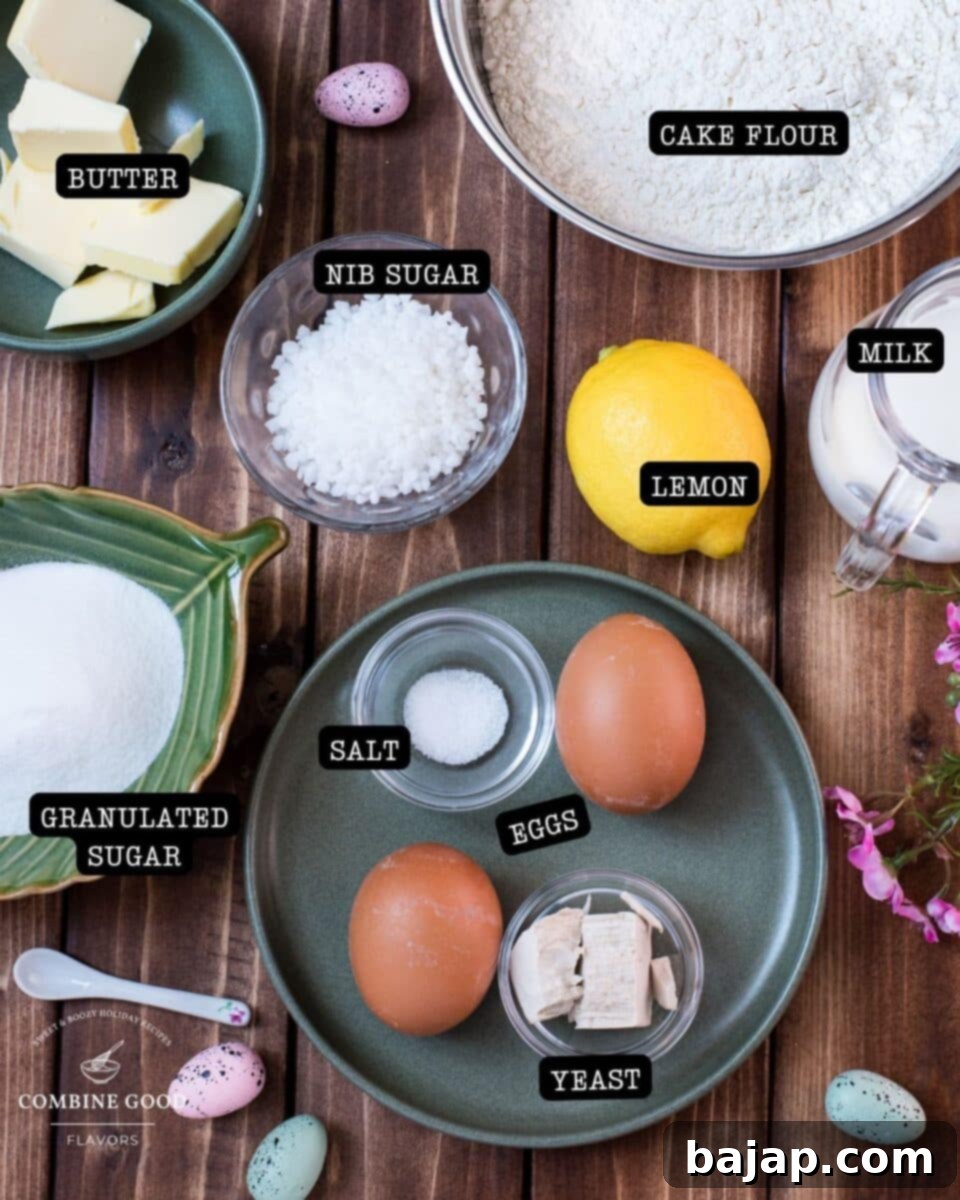
- Lemon: You’ll use the zest from one lemon to add a bright, fresh, and aromatic citrus note that beautifully complements the sweetness of the bread.
- Milk: Warm milk is essential for activating the yeast, ensuring your dough rises perfectly and becomes incredibly soft.
- Fresh yeast or active dry yeast: The leavening agent that gives the bread its airy texture. (Check the detailed tips below for conversions if using active dry or instant yeast.)
- Granulated sugar: Provides sweetness and also feeds the yeast, contributing to a good rise and golden crust.
- Cake flour: The lower protein content in cake flour helps create a tender, soft crumb in your bread. All-purpose flour can be used as a substitute, but cake flour is preferred for that delicate texture.
- Salt: Balances the flavors and strengthens the gluten structure in the dough.
- Eggs (size M): Add richness, color, and structure to the bread. Ensure they are at room temperature.
- Butter, soft: Adds incredible flavor and tenderness to the dough. Using it soft (not melted) allows it to incorporate smoothly.
- Nib sugar for sprinkling: Also known as pearl sugar, this coarse sugar doesn’t melt during baking, providing a delightful crunchy texture and sparkling finish.
- Egg wash: A beaten egg brushed over the wreaths before baking gives them a beautiful, glossy golden-brown crust.
For precise quantities and measurements, refer to the recipe card at the end of this article.
🔪 Step-by-Step Instructions for Braiding Your Easter Wreaths
Follow these detailed steps to create perfectly soft and golden braided Easter bread wreaths. Precision and patience are key when working with yeast dough, so enjoy the process!
Step 1: Prep the Lemon 🍋
Start by giving your lemon a thorough hot water bath, then pat it completely dry. Using a microplane zester, finely grate only the yellow part of the zest, avoiding the bitter white pith. Set this fragrant zest aside – it’s going to infuse your bread with a wonderful citrusy magic!
Step 2: Warm the Milk 🥛
Gently warm the milk in a small saucepan over low heat or in the microwave until it’s lukewarm (about 40-45°C or 105-115°F). It should be warm to the touch but not hot, as excessive heat can kill the yeast. This ideal temperature helps to activate the yeast, setting the stage for the fluffiest Easter bread wreaths possible!
Step 3: Make the Starter Dough (Steam Dough / Pre-Dough / Poolish / Tangzhong!) 🌟
In a medium-sized mixing bowl, crumble the fresh yeast into the warm milk. If using active dry yeast, sprinkle it over the milk and let it sit for 5-10 minutes until foamy. Stir in a pinch of sugar and three tablespoons of cake flour, mixing until the mixture is smooth and free of lumps. Cover the bowl and let this starter dough rest in a warm place for about 15-20 minutes, or until it has visibly doubled in size and appears bubbly. This step, often referred to as a “poolish” or “pre-dough,” significantly improves the flavor and texture of your finished bread.
Step 4: Combine Dry Ingredients 🌿
While your starter dough is rising, sift the remaining cake flour into a separate large mixing bowl. Sifting ensures a lighter dough and prevents lumps. Whisk in the granulated sugar, salt, and your prepared fragrant lemon zest. Distribute these ingredients evenly.
Step 5: Mix & Knead the Dough 🏋️♀️
Once your starter dough has confidently doubled in size, pour it into the bowl with the dry mixture. Briefly mix with a dough hook attachment on a stand mixer (or by hand) until just combined. Then, add the eggs one at a time, followed by the soft butter. Increase the speed to medium-high and knead the dough for about 8-10 minutes. The dough should become smooth, elastic, and will begin to pull away cleanly from the sides of the bowl. This thorough kneading is crucial for developing the gluten, which gives the bread its structure and chewiness.
Step 6: First Rise ⏳
Gather the kneaded dough into a ball and place it back into a clean, lightly oiled bowl. Cover the bowl tightly with plastic wrap or a damp kitchen towel. Let it rise for about 50 minutes in a warm, draft-free spot (like a slightly warmed oven turned off, or near a sunny window). The dough should noticeably double in size and feel light and puffy when gently poked.
Step 7: Divide & Rest 🔪
Gently punch down the risen dough to release the air. Transfer it to a lightly floured surface. Divide the dough into three equal pieces. To make three wreaths, you’ll need three strands per wreath. Therefore, divide each of those three main pieces into three smaller, equal pieces, resulting in a total of 9 equal parts. Cover these smaller dough portions with a kitchen towel and let them rest for another 10-15 minutes. This resting period allows the gluten to relax, making the dough easier to roll and shape without springing back.
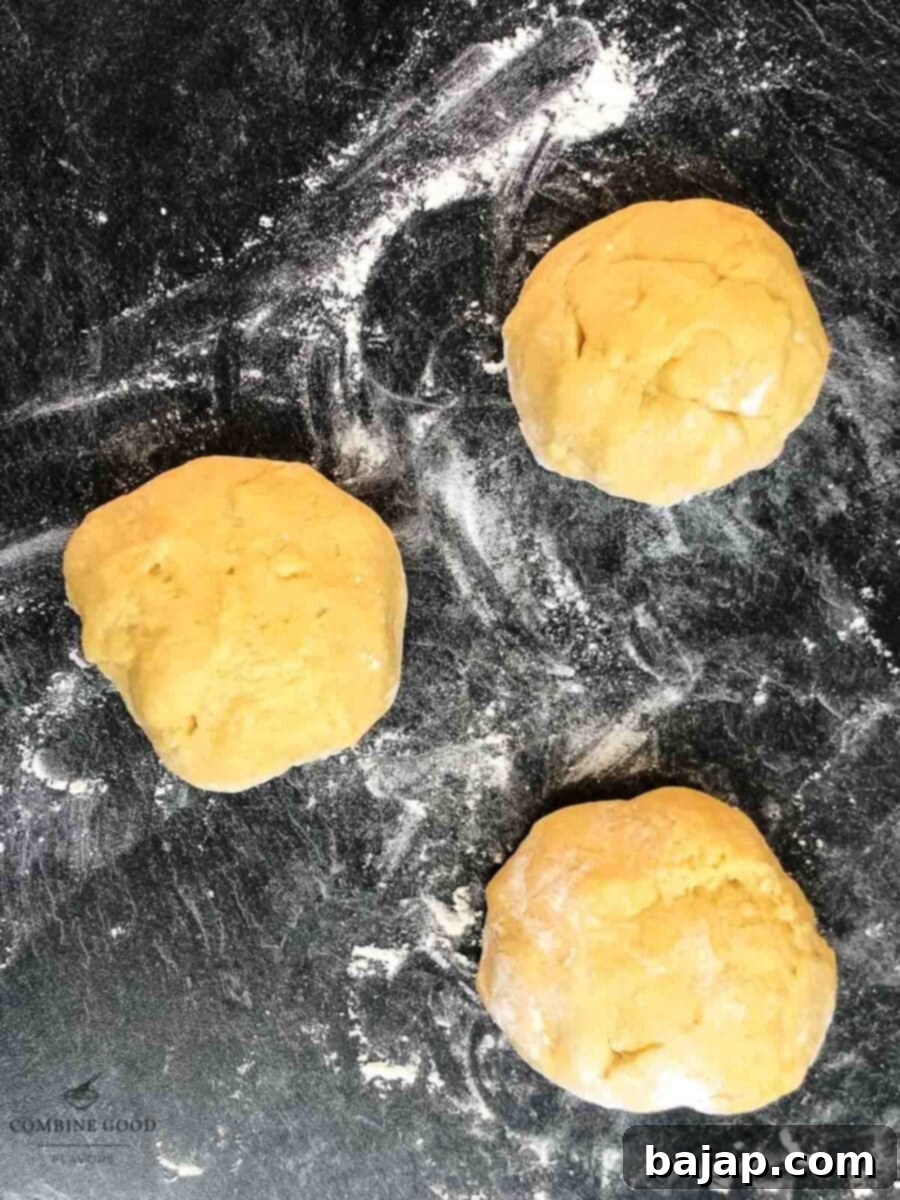
Step 8: Shape the Wreaths 🌸
Take one of the smaller dough pieces and roll it gently on your floured surface into a long, even strand, approximately 30 cm (11.8 inches) in length. Repeat this for two more pieces. Now you have three strands. Pinch one end of the three strands together, then braid them tightly into a neat plait. Once braided, carefully form the plait into a wreath shape, bringing the ends together. Press the ends firmly to seal them, ensuring they hold their shape during baking. Repeat this process for the remaining dough portions to create two more wreaths.
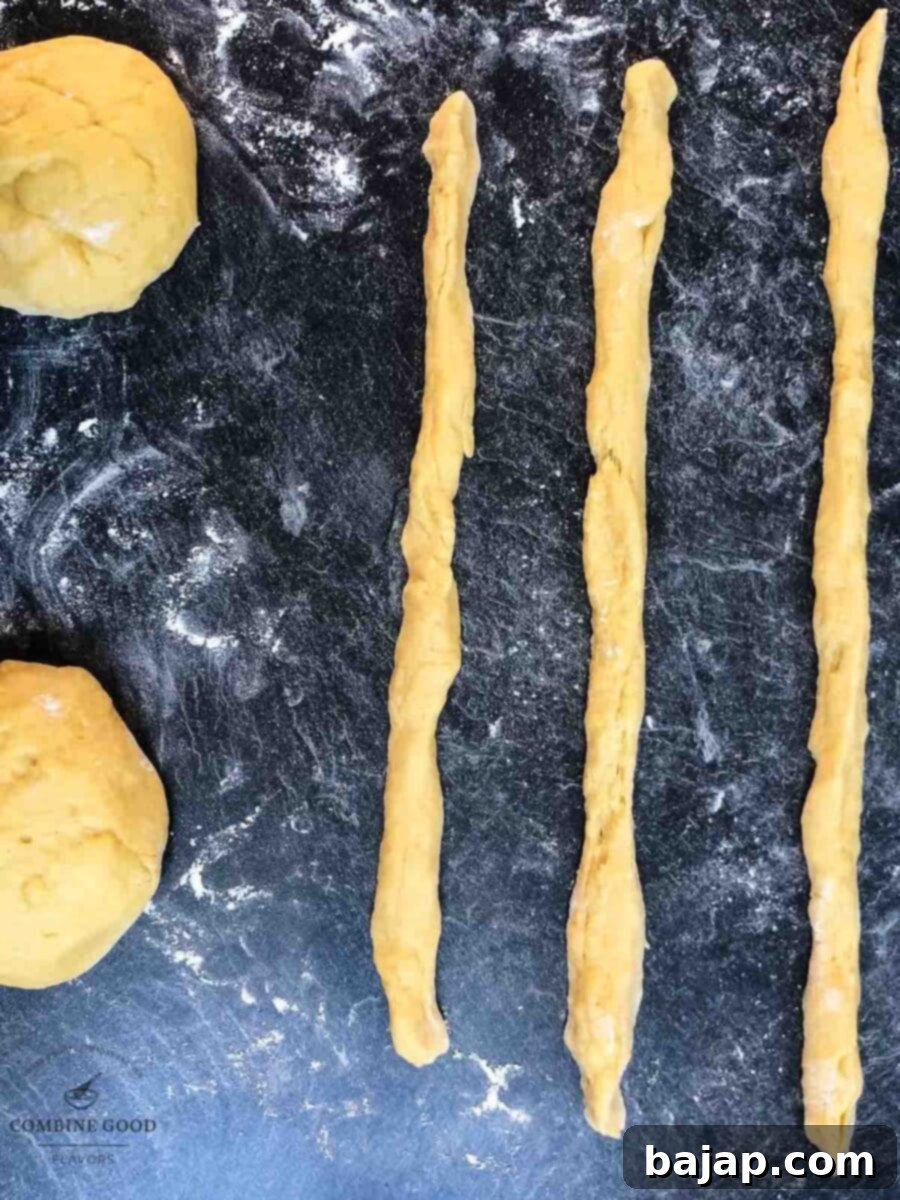
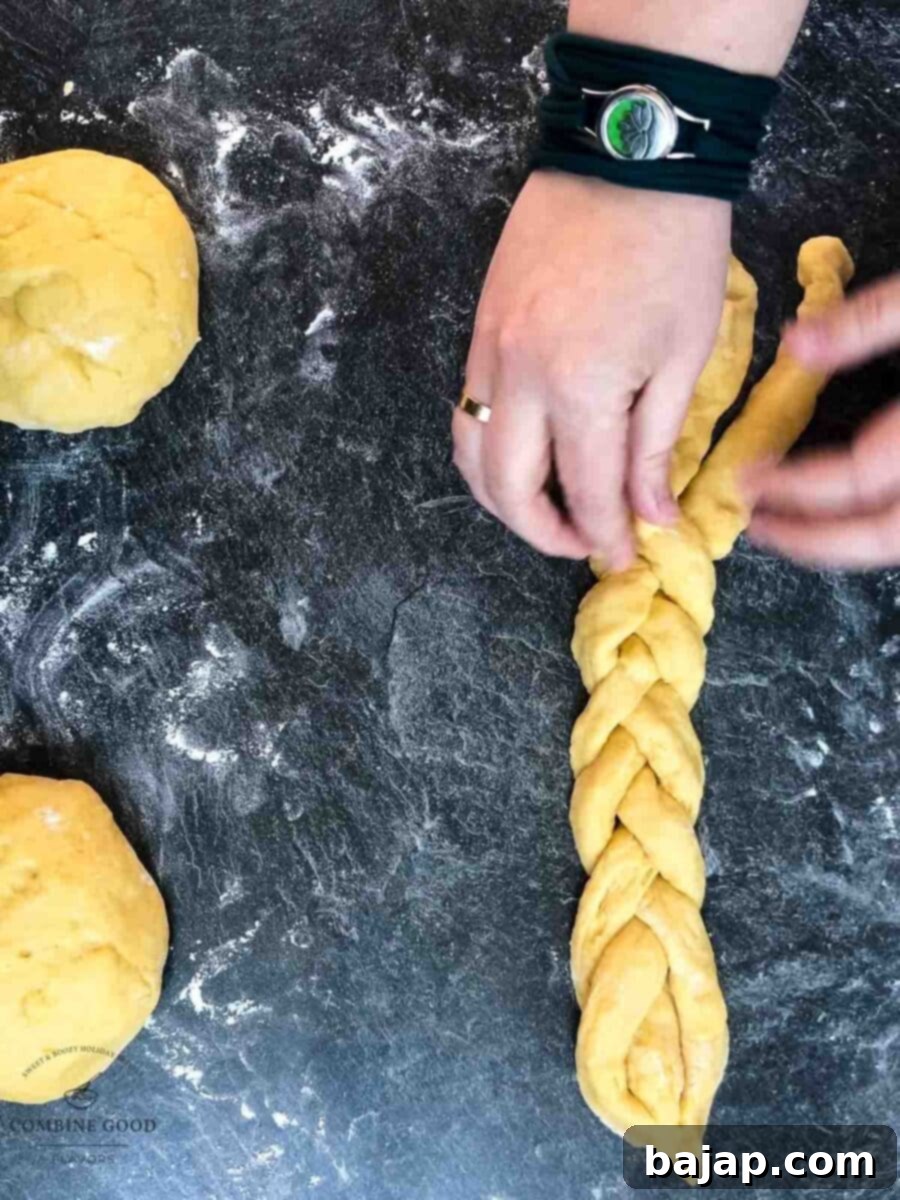
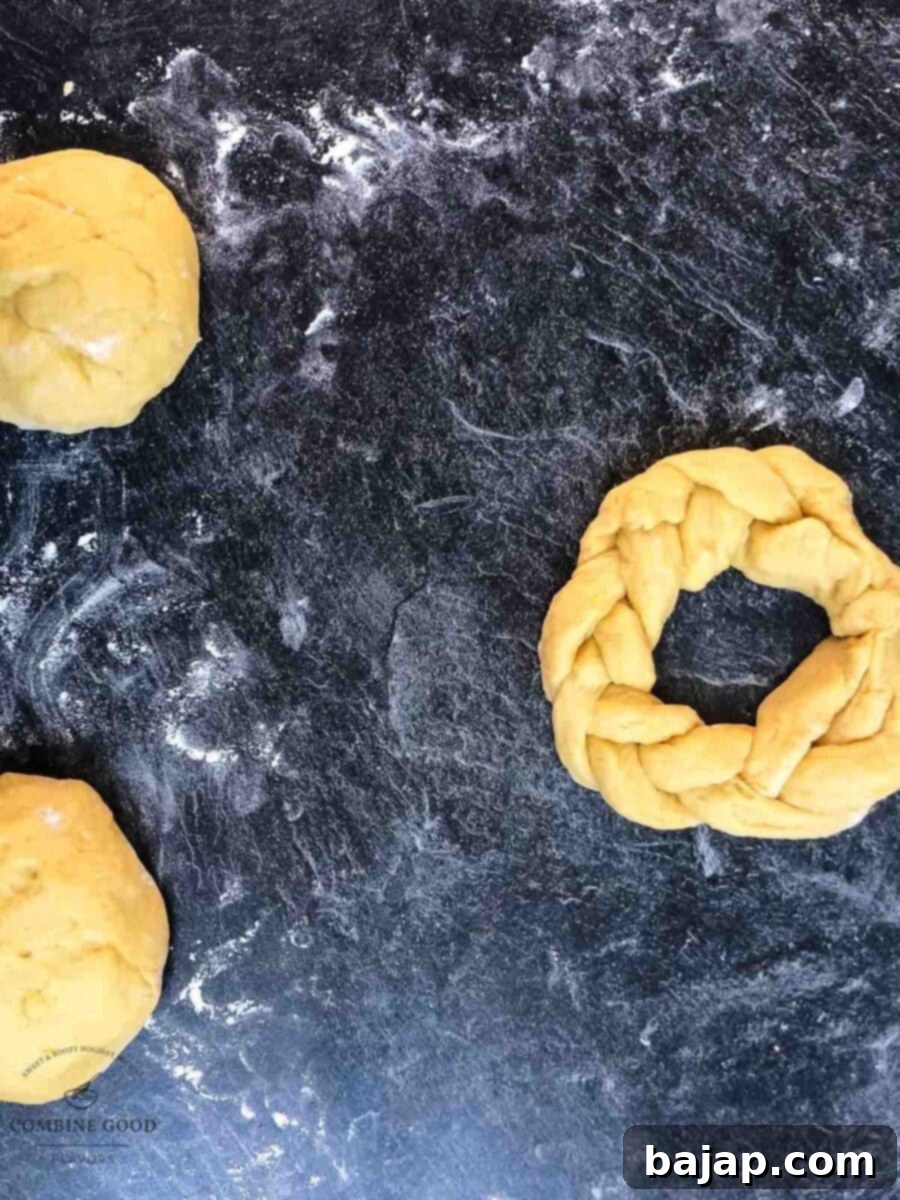
Step 9: Final Rise & Topping ✨
Carefully place your three beautifully shaped wreaths onto a baking sheet lined with parchment paper, ensuring there’s enough space between them for their final rise. In a small bowl, beat the remaining egg to create an egg wash. Gently brush this egg wash evenly over the entire surface of each wreath. This not only gives them a gorgeous golden sheen but also helps the toppings adhere. For that extra sparkle and delightful crunch, generously sprinkle the wreaths with nib sugar. Cover loosely and let them rise for another 30 minutes in a warm spot. This final proofing allows the bread to become even more light and airy.
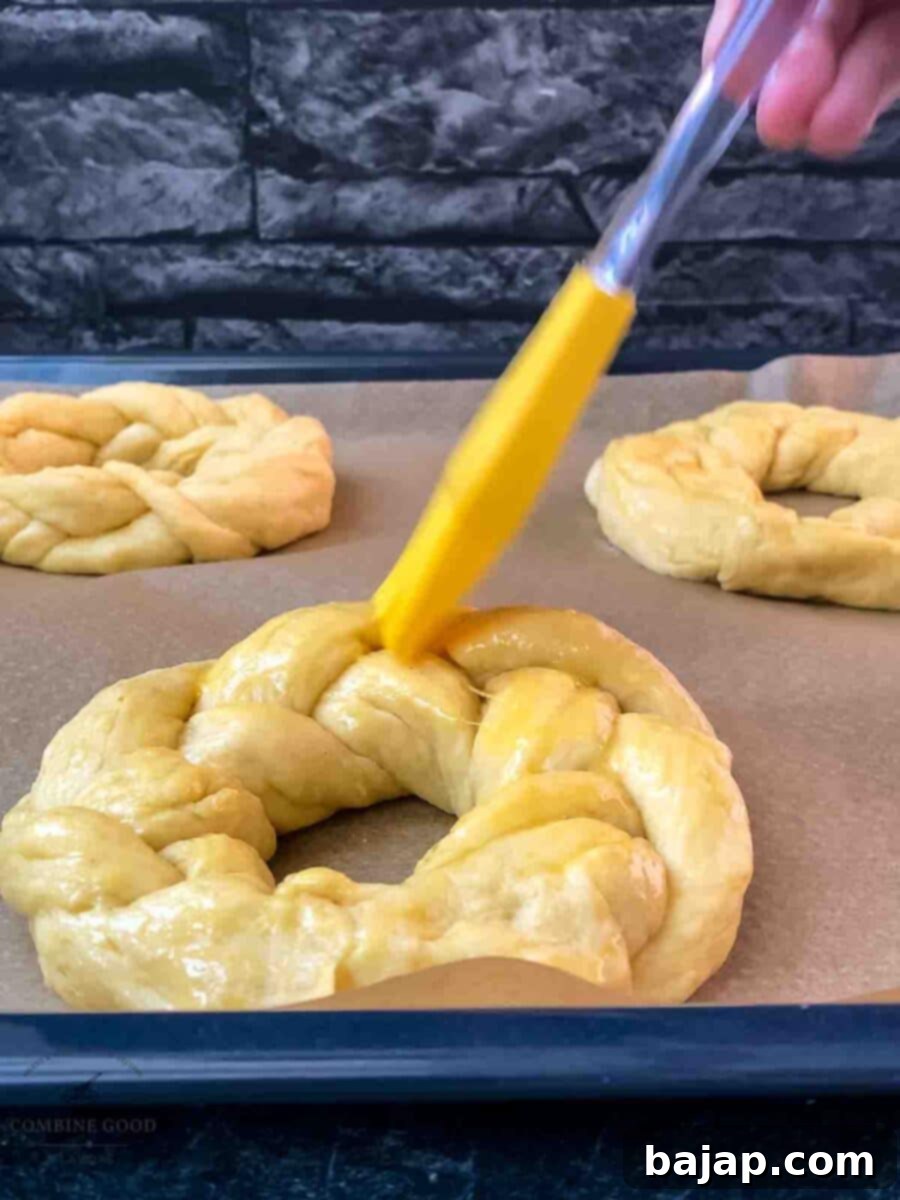
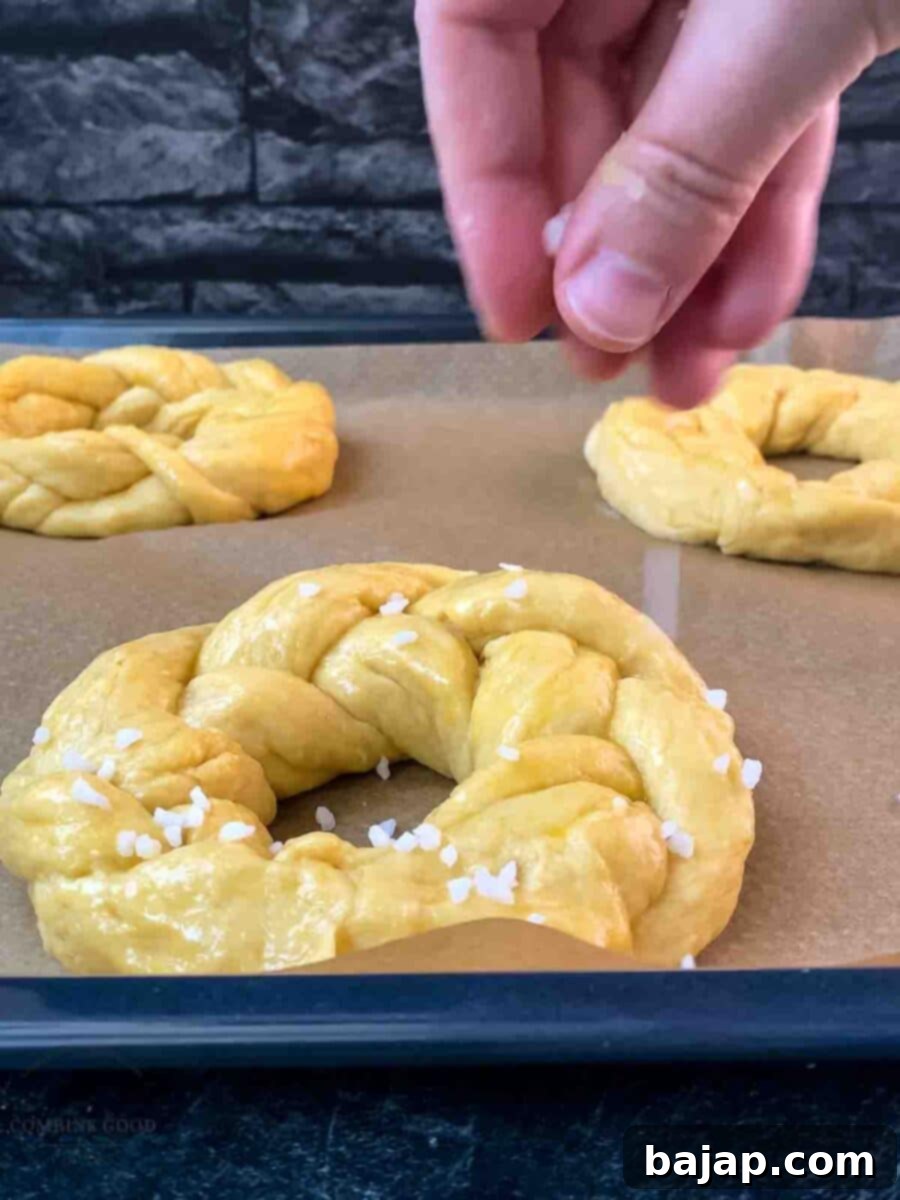
Step 10: Bake to Golden Perfection 🔥
While your wreaths are having their final rise, preheat your oven to 160°C (320°F) on convection mode. If your oven doesn’t have convection, use 180°C (350°F) on a regular bake setting. Bake the wreaths for approximately 25 minutes, or until they turn a gorgeous, rich golden brown and sound hollow when tapped on the bottom. Keep an eye on them towards the end of baking to prevent over-browning.
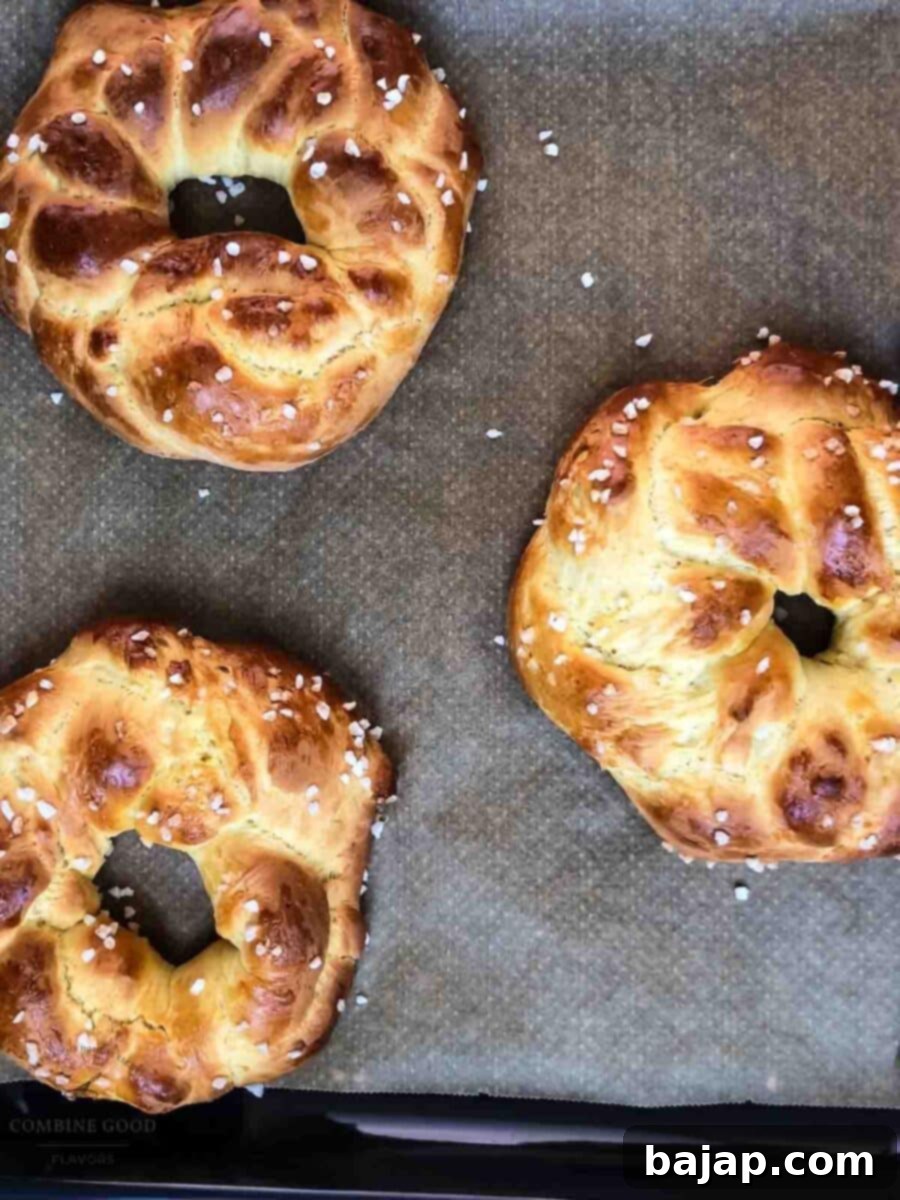
Step 11: Serve & Enjoy! 🎉
Your magnificent Easter bread wreaths are ready to be devoured! For the best experience, serve them warm immediately after baking. The aroma alone will draw everyone to the table, and they’re sure to disappear in minutes. Leftovers can be stored at room temperature in an airtight container for up to 2-3 days, or frozen for longer enjoyment. Reheat gently for that freshly baked taste.
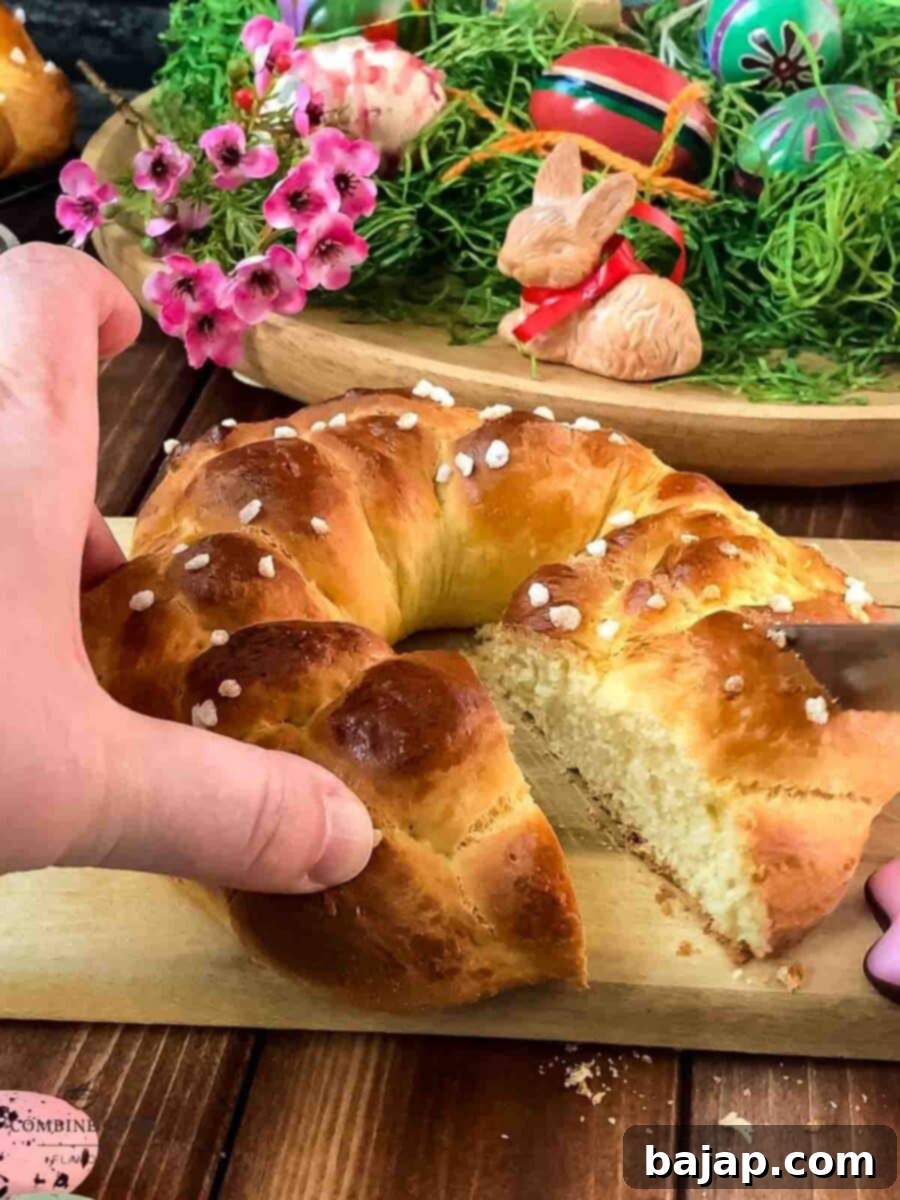
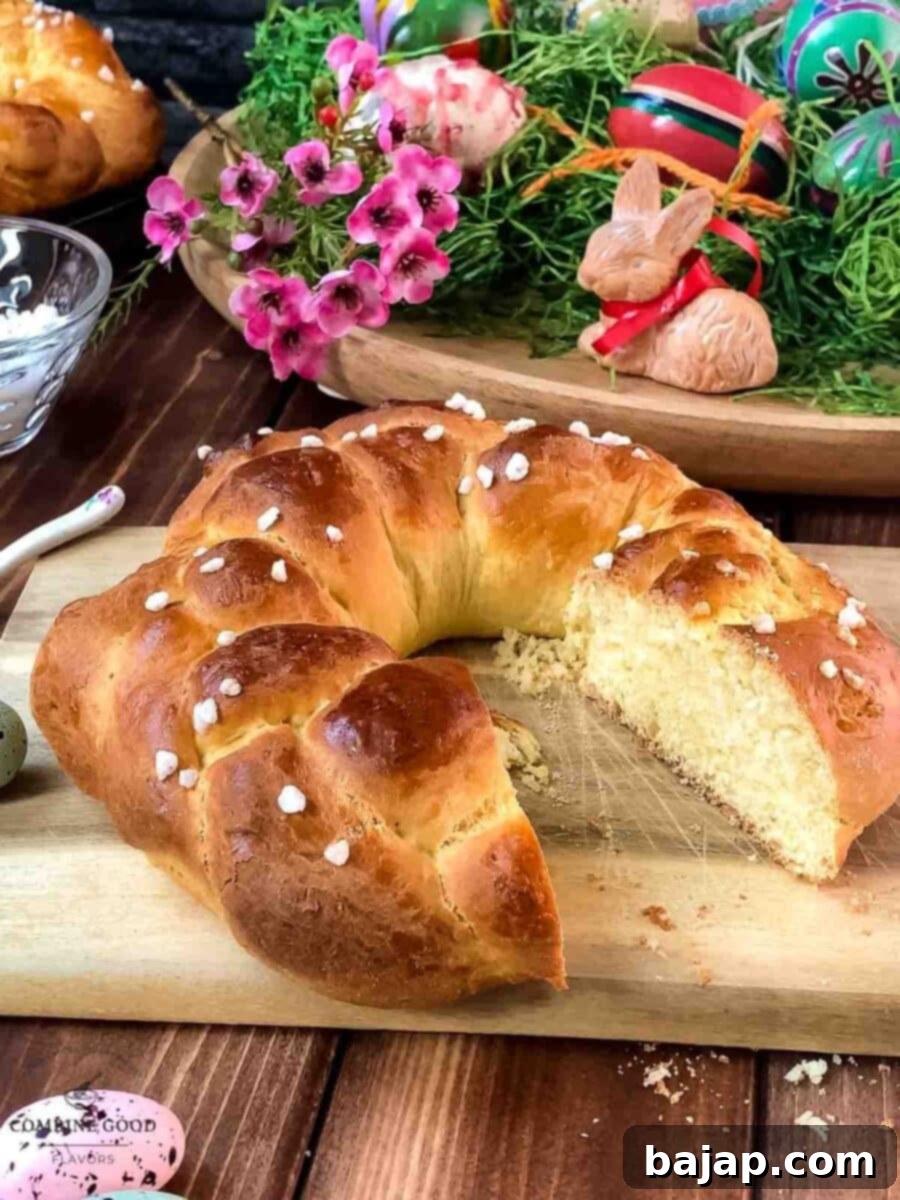
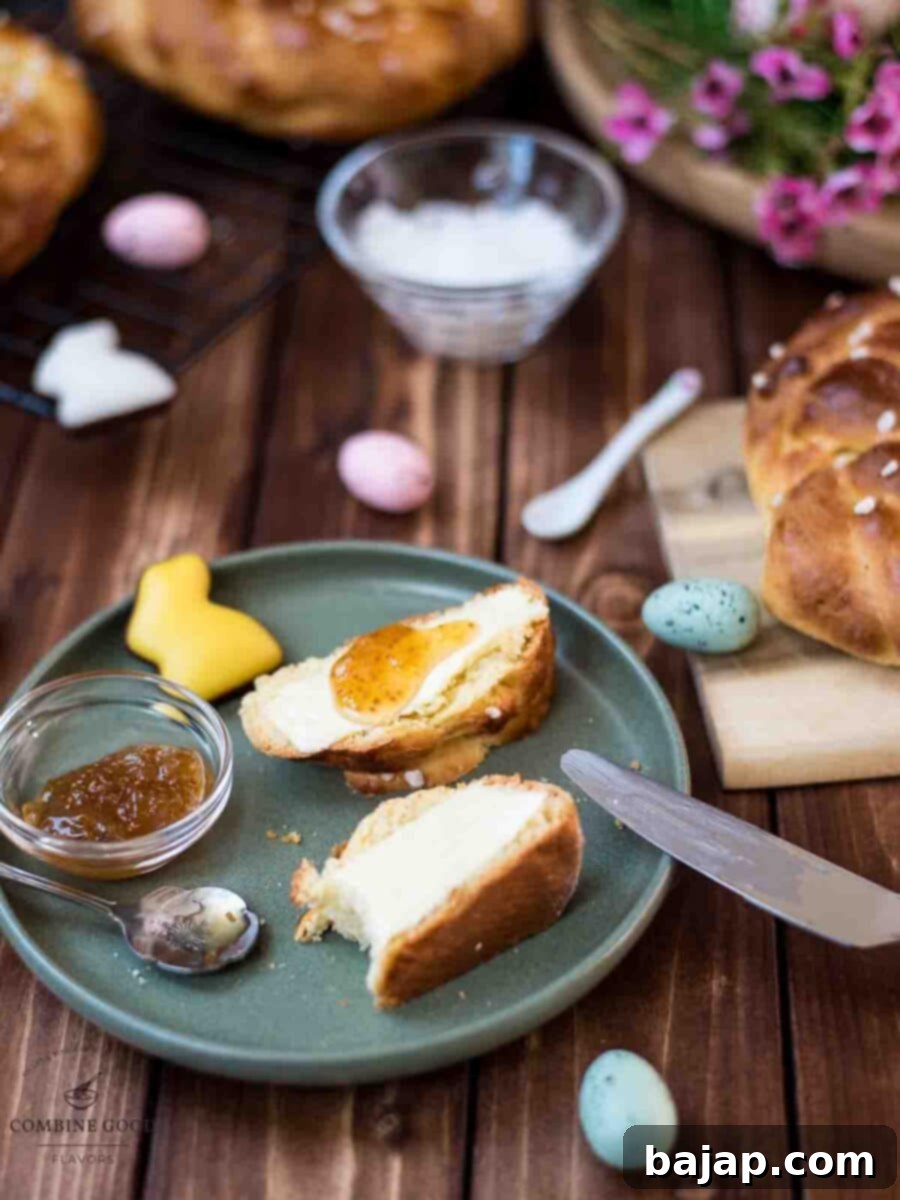
🐰 Variations for Your Braided Easter Bread Wreaths
While the classic nib sugar topping is always a hit, feel free to get creative with your braided Easter bread wreaths! Here are a few ideas to customize them:
- Nutty Topping: Instead of, or in addition to, nib sugar, sprinkle the wreaths with flaked almonds or chopped pistachios prior to baking. They add a lovely texture and nutty flavor.
- Dried Fruit Infusion: Incorporate ½ cup of finely chopped dried cranberries, golden raisins, or candied orange peel into the dough during the last few minutes of kneading for extra sweetness and chewiness.
- Cinnamon Swirl: After rolling out each dough strand but before braiding, brush it lightly with melted butter and sprinkle with cinnamon sugar for a delightful swirl effect.
- Orange Zest: For an even more pronounced citrus flavor, add zest from an orange along with the lemon zest.
- Glaze Finish: After baking and cooling slightly, drizzle a simple glaze over the wreaths. Mix powdered sugar with a little lemon juice or milk until smooth.
🍽 Essential Equipment for Baking Success
Having the right tools can make all the difference in your baking journey. Here’s the equipment you’ll need for these Easter bread wreaths:
- Microplane zester: Perfect for finely grating citrus zest without catching the bitter white pith.
- Hand or stand mixer with dough hook attachment: Essential for efficiently kneading the dough to the proper consistency, saving you a lot of manual effort.
- Mixing bowls: You’ll need at least two: one for the starter dough and one for combining dry ingredients.
- Baking tray lined with parchment paper: Prevents sticking and makes for easy cleanup.
- Saucepan or microwave-safe bowl: For gently warming the milk.
- Sieve: To sift the flour and ensure a light, airy dough.
Yeast Note for International Bakers 🇦🇹🇺🇸
Understanding yeast conversions is crucial for successful baking, especially when recipes originate from different regions.
In Austria and much of Europe, we commonly use fresh yeast cubes for baking. These are typically sold in 42g (1.5 oz) portions and provide a very reliable and active leavening agent.
If you’re baking in the USA or another region where fresh yeast is harder to find, don’t worry! You can easily substitute it with dry yeast. Here’s how:
- Active Dry Yeast: This type of yeast needs to be activated in warm liquid before being added to your dry ingredients. When substituting for fresh yeast, use half the amount. So, for a 42g cube of fresh yeast, you would use 21g of active dry yeast, which is approximately 2 ½ teaspoons. Dissolve it in your warm milk (Step 2) for 5-10 minutes until it becomes foamy before proceeding.
- Instant Yeast (Rapid-Rise / Bread Machine Yeast): This yeast is designed to be added directly to the dry ingredients without prior activation. Use ⅓ of the fresh yeast amount. For a 42g cube of fresh yeast, you would use about 14g of instant yeast, which is roughly 2 teaspoons. You can simply mix this directly with your flour in Step 4.
Pro Tip: If you’re fortunate enough to find cake yeast in the refrigerated section of a US grocery store, it’s the closest equivalent to European fresh yeast and can be used in the same quantity specified for fresh yeast.
Our recipe specifically calls for ½ cube, which is 21g (0.75 oz) of fresh yeast.
Other Delightful Easter Recipes for You to Try
If you’re looking to expand your Easter culinary repertoire, explore these other fantastic recipes from our collection:
- Vegan Easter Cookies with Apricot Jam
- Easter Cut Out Cookies with Pistachio Ganache
- Chocolate Chip Vanilla Ice Cream
- Aperol Mimosa
- Classic Mimosa Recipe
- Pistachio Rolls
- Simple Layered Eggnog Vanilla Pudding Dessert
- Potato Flour Cake with Eggnog
- Delicious Linzer Cookies with Egg Liqueur
- Stracciatella Egg Liqueur Milkshake Recipe
If you embark on this delightful baking adventure and make this recipe, I’d absolutely love to hear about it! Please let me know how you liked it by giving it a ★★★★★ star rating and leaving a comment below. Your feedback is truly awesome and helps others discover this recipe! You can also sign up for our Newsletter to receive weekly delicious homemade recipes directly in your inbox, or follow me on Pinterest or Instagram and share your beautiful creation with me. Just tag me @combinegoodflavors and hashtag #combinegoodflavors, so I don’t miss it!
📖 Recipe: Soft & Fluffy Braided Easter Bread Wreaths

Easter Bread Wreath
By Nora
5 from 5 votes
Save Recipe
Pin Recipe
Equipment
-
Microplane zester
-
Hand or stand mixer with dough hook attachment
-
Mixing bowls
-
Baking tray lined with parchment paper
-
Saucepan or microwave-safe bowl
-
Sieve
Ingredients
- 1 Lemon (zest)
- ⅔ cup Milk
- ½ cube Fresh yeast (21g / 0.75 oz) or 2 ½ tsp active dry yeast
- ½ cup Granulated sugar
- 3 ¼ cup Cake flour + flour for the counter top
- ¼ teaspoon Salt
- 2 Eggs size M
- 4 ¼ tablespoon Butter soft
- Nib sugar for sprinkling
- 1 Egg for brushing on (egg wash)
Instructions
-
Wash 1 Lemon with hot water, pat it dry, and finely grate the zest. Set aside for later.1 Lemon
-
Gently warm ⅔ cup Milk in a saucepan or microwave until it’s just warm to the touch (lukewarm), but not hot.⅔ cup Milk
-
Prepare the starter dough: In a mixing bowl, crumble ½ cube Fresh yeast (or equivalent active dry yeast as per note) into the warm milk. Stir in a pinch of granulated sugar and 3 tablespoons of cake flour, then mix until smooth. Cover and let it rest in a warm spot until it has visibly doubled in size (approx. 15-20 minutes).½ cube Fresh yeast
-
Sift the remaining 3 ¼ cup Cake flour into a separate large bowl. Whisk in the ½ cup Granulated sugar, ¼ teaspoon Salt, and the grated lemon zest until well combined.½ cup Granulated sugar, 3 ¼ cup Cake flour, ¼ teaspoon Salt
-
Once the starter dough has doubled in size and is bubbly, add it to the dry mixture in the large bowl and mix briefly with a dough hook until just combined.
-
Add the 2 Eggs (one at a time) and the soft 4 ¼ tablespoon Butter. Continue to knead the dough on high speed using a dough hook for about 8-10 minutes until it becomes very smooth, elastic, and pulls away from the sides of the bowl.2 Eggs, 4 ¼ tablespoon Butter
-
Form the dough into a ball, place it in a lightly oiled bowl, and cover it tightly. Let the dough rise for 50 minutes in a warm, draft-free spot until it has doubled in size.
-
Gently punch down the risen dough to deflate it. Transfer to a lightly floured surface and divide it into 3 equal large pieces. Then, divide each of these 3 pieces into 3 smaller, equal portions (you will have 9 total smaller portions). Cover these with a clean kitchen towel and let them rest for 10-15 minutes to relax the gluten.
-
Take three of the smaller dough portions. Roll each one into a uniform strand, approximately 30 cm (11.8 inches) long. Pinch one end of the three strands together and braid them into a plait. Form this braided plait into a wreath shape, bringing the ends together and pressing them firmly to seal. Repeat this process for the remaining six dough portions to create two more wreaths.
-
Place your three beautifully braided bread wreaths on a parchment-lined baking sheet, ensuring there is ample space between them for expansion.
-
Beat 1 Egg to create an egg wash, then gently brush it evenly over all the wreaths. Generously sprinkle with Nib sugar for a sweet crunch and sparkling finish. Let the wreaths rise for another 30 minutes.Nib sugar, 1 Egg
-
Preheat your oven to 160°C (320°F) using the convection setting (or 180°C / 350°F for conventional ovens). Bake the wreaths for approximately 25 minutes, or until they are beautifully golden brown and sound hollow when tapped on the bottom.
-
Serve your delightful Easter bread wreaths immediately after baking, while they are still warm and at their absolute best. Enjoy on Easter morning or even the next day!
Notes
Instant Yeast (Rapid-Rise / Bread Machine Yeast): If using, use ⅓ of the fresh yeast amount (for 42g fresh yeast, use 14g instant yeast ≈ 2 teaspoons). This type can be mixed directly with the flour in Step 4 without prior activation.
Nutrition values are estimates only, using online calculators. Please verify using your own data.

⛑️ Food Safety Guidelines for Baking and Handling
Ensuring food safety is paramount when baking, especially with yeast and eggs. Follow these guidelines to keep your kitchen and food safe:
- Cook all ingredients, especially those containing eggs, to a minimum internal temperature of 165 °F (74 °C) to eliminate harmful bacteria.
- Always use separate utensils for raw ingredients (like raw dough or raw egg wash) and cooked food to prevent cross-contamination.
- Thoroughly wash your hands with soap and warm water before and after handling raw ingredients, particularly eggs and dough.
- Do not leave food sitting out at room temperature for extended periods (generally no more than two hours) to prevent bacterial growth.
- Never leave cooking food unattended, especially when using an oven, to avoid accidents.
- When cooking at high temperatures, opt for oils with a high smoking point to prevent the formation of harmful compounds.
- Always ensure good ventilation in your kitchen, especially when using a gas stove, to maintain air quality.
For more comprehensive information on safe food handling practices, please consult the official resources at Safe Food Handling – FDA.
These Braided Easter Bread Wreaths are more than just a recipe; they are an invitation to create lasting memories and delicious traditions. With their soft texture, delicate sweetness, and beautiful presentation, they embody the spirit of Easter. Happy baking, and enjoy every delightful bite with your family and friends!
